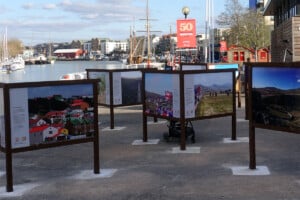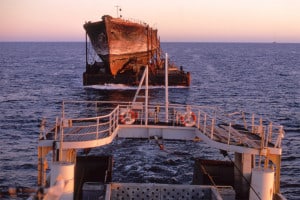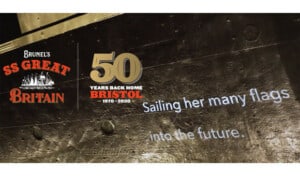Falklands to Bristol: an Extraordinary Journey – Exhibition – Part I
Exhibition curators, Natalie Fey, Joanna Mathers and Dr Kate Rambridge, introduce the 12 photographs within the exhibition, selected to tell the story of the audacious rescue and homecoming journey (a further 12 photographs depict life in the Falkland Islands today):
We are really lucky to be able to see the salvage and rescue of Brunel’s SS Great Britain through the eyes of those that were there. Photographers Tony & Marion Morrison documented the entire salvage operation, and have kindly given us permission to choose images from their amazing archive. Other shots were captured by Bernard Schmidt, an electrician who worked as part of the salvage crew, and media photographers who worked freelance for newspapers. The decision on which few images to use – out of around two hundred – was incredibly tough.
At the same time, we worked with project partners from the Falkland Islands Government and Falkland Islands Association, selecting 12 images to tell the story of the Falkland Islands community today. It was a privilege to work with these Islanders, and to learn so much about daily life on the islands.


The story of the SS Great Britain’s rescue really starts in 1886, before her period of isolation in the harsh landscape of Sparrow Cove. She spent 51 years as an integral part of the Falkland Islands community, after she was damaged in a storm off the coast of San Francisco and sold to the islands as a huge floating warehouse for storing goods such as wool and coal. By 1937 she had become too fragile and hazardous to other ships in the area and was eventually towed out and left alone, in desolate Sparrow Cove. to waste away.
We decided to present a thought provoking and stark contrast by pairing the first image you can see above, taken in the 1960’s; most likely by a postal plane, with the second photo of the ship as she looks today nestled comfortably in the historic harbourside here in Bristol, where she was built and launched in 1843. Working on capturing the image of the ship as she looks now was particularly exciting and required an early morning trip around the site with staff member Mo Malik and Dave the Drone! This for me was a particularly memorable moment as I got the opportunity to see views of the ship that I had never seen during my eight years working for the Trust.


We chose the photo of the top (weather) deck as it shows the derelict and fragile condition of the abandoned ship. The colour and drama of the tired ship is mirrored beautifully against the ruggedness of the exposed island landscape in the background. Once the salvage crew arrived, the first major piece of work that took place was to cut and lower the ship’s three masts that had been standing for 113 years. This was to ensure the SS Great Britain’s stability on the salvage pontoon. There is something about seeing that mast dangling perilously just above the cargo hatch that really captures the sheer audacity of the operation.
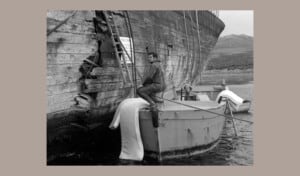
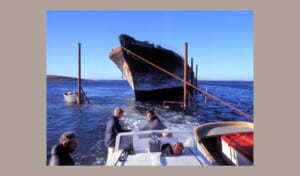
It was very evident from initial inspections of the SS Great Britain’s structure that the hull was under increasing strain as the tides flexed against the ageing ship. This image shows salvage diver Stuart Whatley preparing to use the unusual technique of stuffing mattresses into the large crack running down the starboard side of the ship to help create a temporary watertight seal. This was part of the work to prepare the ship to float again. Next, the water that had flooded the inside of her hull was pumped out to make her buoyant so that she could float onto the pontoon Mulus III. The next technicolour image, captured beautifully by photographer Marion Morrison, shows the tense moment the SS Great Britain was carefully guided over the submerged pontoon. Once the ship was positioned correctly the team used compressed air to expel the water ballast from the tanks, and as the pontoon slowly rose and floated it lifted the ship out of the sea.


Once the SS Great Britain had been safely secured to the pontoon, she docked in Stanley for a few final preparations before her long journey north. The community came out to say goodbye to the old ship which had been part of their landscape for 84 years. As the SS Great Britain was formally a ‘Crown Wreck’ belonging to Queen Elizabeth II, it was the duty of the Falkland Islands Governor, Sir Cosmo Haskard to hand over responsibility of care for the ship to the SS Great Britain Project. This moment was wonderfully captured from the deck of the SS Great Britain by Bernard Schmidt, an electrician working as part of the salvage team.
Finally, on 24 April 1970 at around 9 o’clock in the morning the salvage convoy left the Falkland Islands to complete the first part of their 8,000 mile long journey home to Bristol. They would need to call in to the port of Montevideo in Uruguay to prepare the ship and pontoon for the trans-Atlantic crossing, refuel the Varius II and restock supplies. This photo literally captures the calm before the storm as the convoy left Stanley. During the worst of the weather, the crew on board the tug Varius II couldn’t bear to look back at the pontoon carrying the fragile structure of the 127-year-old ship but when morning broke, they saw she was still safely under tow.

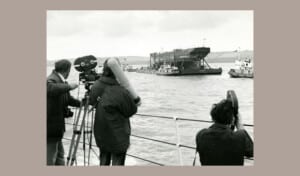
The image of the bathers captures a moment of much needed down time during the momentous expedition to bring the SS Great Britain home. Whilst travelling up the coast of South America the weather was hot and sultry, so to keep cool the salvage crew set up a makeshift pool on the deck of the tugboat Varius II. It would be another 49 days before they would reach the docks of Avonmouth.
It was 24 June 1970 when the SS Great Britain towed by Varius II made its final approach towards Avonmouth docks. This is where local tugs such as the Sea Alert and Talgarth took over the tow from Varius II. The second image above shows photographers recording the first glimpses of the ‘grand old lady’ returning home from her final voyage.
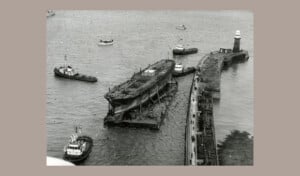
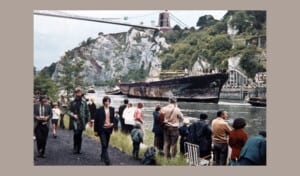
This shot captured for the Daily Telegraph shows the Bristol tugs carefully moving Mulus III past the pier and into drydock at Avonmouth, a truly incredible feat of skill on the part of the tug captains. Here SS Great Britain left the pontoon and was laid up for repair. It was essential that the ship was able to float on her own bottom up the River Avon. This was an incredibly risky endeavour because the slightest miscalculation could cause the ship to sink and block the river.
It was an early summer morning on 5 July 1970 when thousands of people came out to witness the SS Great Britain journey up the Avon and for the first and last time pass under Brunel’s Clifton Suspension Bridge. She would settle home back into the Great Western Dockyard exactly 127 years to the day since she left.
Authors: Kate Rambridge, Natalie Fey and Joanna Mathers

